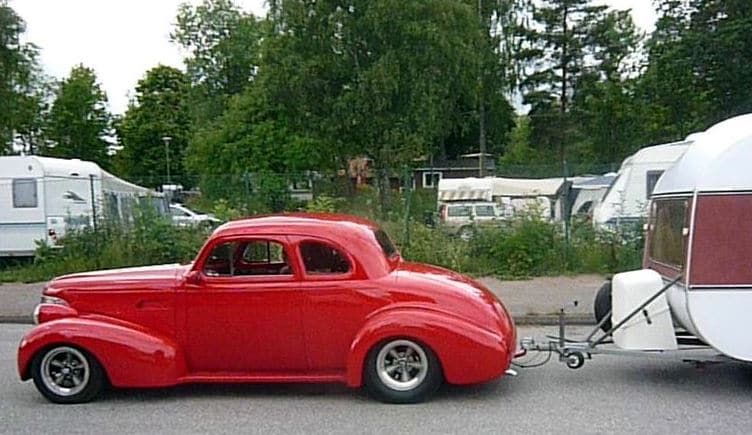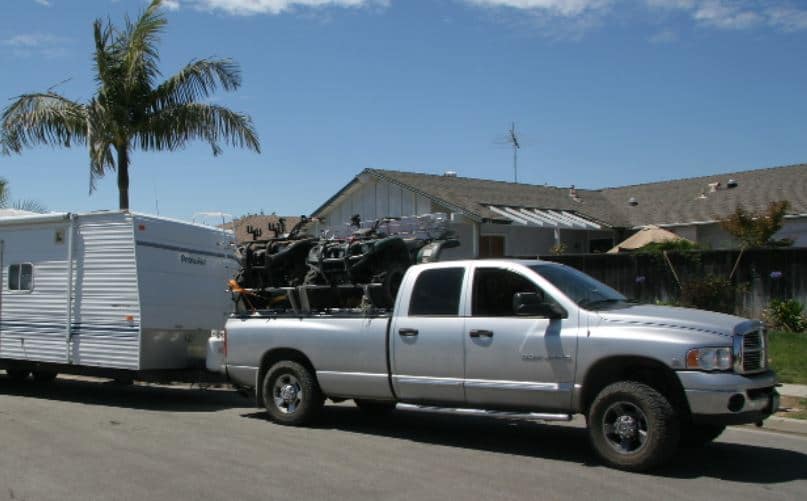Hitch receiver sizes can be confusing. You may be wondering: what size tow hitch do I have, and is it big enough to fit what I’m trying to tow?
When it comes to towing, you need the right equipment for the job.
One of the most important pieces of gear is your hitch receiver.
This component attaches your trailer to your vehicle, so it’s important to know the different sizes that tow hitch receivers come in.
We’ll cover all the different hitch receiver sizes, what classes of tow hitch they correspond to, and help you choose the correct receiver size for your vehicle.
Hitch Receiver Sizes

There are four main sizes of tow hitch receivers available: 1-1/4″, 2″, 2-1/2″, and 3″.
The measurement refers to the width of the opening on the receiver, not the width of the receiver itself.
We’ll go over each of these in-depth in today’s guide.
Why Receiver Size Matters
As we covered, the smaller the receiver opening, the smaller the hitch accessory that will fit in it.
The smaller the hitch accessory or tube is, the less weight it will be able to carry.
This is why it’s so important to never exceed the weight limit of your hitch accessory to avoid damage to your vehicle, hitch receiver, and other equipment.
Receiver Size And Hitch Class
Each receiver size is usually defined to a class or grouping of hitches, ranging from class I to V (1 to 5).
As the hitch classes increase, the more weight and larger items can be towed.
Each vehicle will have a certain maximum hitch class that can be installed on it in order to not exceed it’s towing capacity.
This is why it’s so important to choose the proper hitch class for your vehicle.
Check out this cheat sheet showing the relationship between hitch receiver size, hitch class, and towing weight:
Tow Hitch Receiver Sizes
| Hitch Receiver Size | Hitch Class | Maximum Gross Trailer Weight (GTW) | Maximum Tongue Weight (TW) | Vehicle Types |
|---|---|---|---|---|
| 1-1/4" | Class I / Class 1 | 2,000 lbs | 200 lbs | Cars, Crossovers, Some Small SUVs |
| 1-1/4" | Class II / Class 2 | 3,500 lbs | 350 lbs | Cars, Crossovers, Small Vans, Small SUVs |
| 2" | Class III / Class 3 | 8,000 lbs | 800 lbs | Crossovers, Vans, SUVs, 1/4-Ton and 1/2-Ton Trucks |
| 2" | Class IV / Class 4 | 12,000 lbs | 1,200 lbs | Crossovers, Vans, SUVs, 1/4-Ton and 1/2-Ton Trucks |
| 2-1/2" | Class V / Class 5 | 20,000 lbs | 2,000 lbs | Heavy-Duty Trucks |
| 3" | Class V / Class 5 | 25,000 lbs | 4,000 lbs | Commercial Vehicles (Flatbeds, Dump Trailers, etc.) |
Now that we’ve got our key info down, let’s move on to hitch receiver sizes and hitch classes.
1-1/4″ Receiver Size: Class I & Class II Hitches

Class I and Class II trailer hitches usually have a 1-1/4″ (1.25″) square opening.
These are usually found on small SUVs, smaller vans, and cars that are towing very lightweight loads or lightweight trailers.
Class I trailer hitch weight ratings generally have maximum gross trailer weight of 1,000-2,000 lbs and a maximum tongue weight of 100-200 lbs.
Class II trailer hitch weight ratings generally have maximum gross trailer weight of 2,000-3,000 lbs and a maximum tongue weight of 200-525 lbs.
2″ Receiver Size: Class III and Class IV Hitches

Class III and Class IV hitches usually have a 2″ square opening.
These hitches are usually found on SUVS, crossovers, quarter-ton half-size pickup trucks (like the Colorado, Canyon, Tacoma, and Frontier), half-ton full-size pickup trucks (like the F-150, Titan, Ram & Chevy 1500, and Tundra), and a few full-size four-door cars, such as sedans.
The most common factory-installed hitch receiver sizes are 2″.
The important distinction of a 2″ hitch receiver is that they’re rated for use with weight distribution hitches, meaning that you can get the most towing capacity out of them.
Class III trailer hitch weight ratings typically have maximum gross trailer weight of 3,500-8,000 lbs and a maximum tongue weight of 300-800 lbs.
Class IV trailer hitch weight ratings usually have maximum gross trailer weight of 5,000-12,000 lbs and a maximum tongue weight of 500-1,200 lbs.
It’s important to note that some 2″ size hitch receivers can be classified as Class V hitches if they have increased weight capacity or extra reinforced construction.
2-1/2″ (2.5″) Receiver Size: Class V Hitches

Class V hitches can have either a 2-1/2″ (2.5″) or 3″ opening, making them a little different than Class I to Class IV hitches.
You’ll only see 2-1/2″ Class V hitches on extremely capable heavy-duty trucks.
2-1/2″ (2.5″) Class V hitch weight ratings have maximum gross trailer weight of 10,000-20,000 lbs and a maximum tongue weight of 1,000-2,000 lbs.
3″ Receiver Size: Class V Hitches

There are two key differences between a 2-1/2″ (2.5″) Class V hitch and a 3″ Class V hitch: the size of the opening, and how it’s installed on the vehicle.
Most hitches are bolted to the frame of the vehicle, but 3″ Class V hitches are welded to the C-channel frame.
You’ll usually find 3″ Class V hitches on flatbeds, dump trailers, and other commercial trucks.
3″ Class V hitch weight ratings range from 20,000-25,000 lbs and have a maximum tongue weight of 3,000-4,000 lbs.
What Size Receiver Hitch Do I Have?
To determine what size receiver hitch you have on your vehicle, simply take a measuring tape and measure the inside of the tube to the other inside of the tube.
The measurement should be 1-1/4″ (1.25″), 2″, 2-1/2″ (2.5″), or 3″.
This will tell you what size hitch accessory you’ll need to work with your receiver hitch.
Check out this video showing you exactly how to measure and find out what size receiver hitch you have:
Frequently Asked Questions
Yes, there are different size receiver hitches. They are all square openings, ranging 1-1/4″ (1.25″), 2″, 2-1/2″ (2.5″) and 3″.
Each opening is assigned to a different class of hitch, ranging from I to V (1-5). As the hitch class increases, so does the amount of weight and tongue weight they can handle.
A 2.5 inch receiver hitch is a Class V (class 5) hitch, usually used on heavy-duty trucks.
A Class 3 (Class III) receiver hitch is 2 inches, usually used on SUVs, quarter and half-ton trucks, crossovers, and full size sedans.


